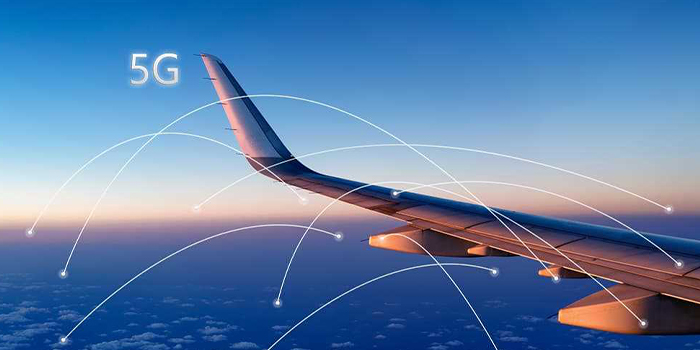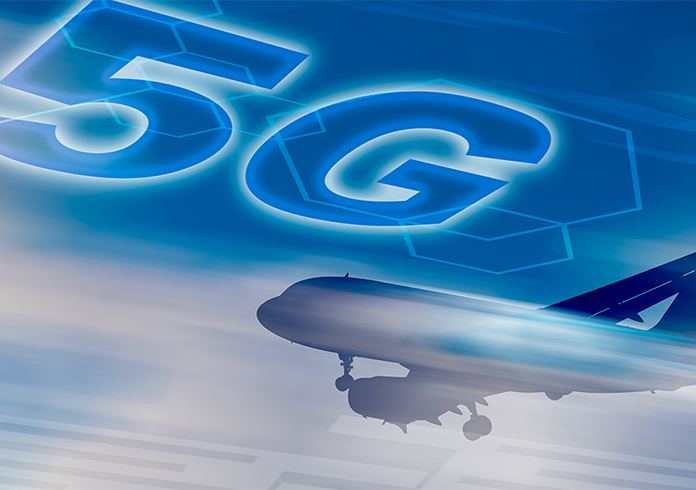Evolution 5G is a key wireless networking and communication technology that connects aviation infrastructure and data generation and transmission technologies to end users. By replacing 4G LTE hardware and communication infrastructure, fifth-generation mobile networks aim to advance wireless communication and networking technologies. The move from 4G LTE to 5G connectivity promises to provide quicker internet access than earlier technologies. The fundamental purpose of 5G Technology is to increase the aircraft technology span of the Internet of Things, as well as the ideas of virtual reality and augmented reality. The possibility of combining digital technology with a huge number of individual users is great with 5G technology. Many end-user industries in the worldwide market have invested heavily in 5G technology. Because of an increase in passenger footfall, there is a large increase in demand for greater bandwidth and quicker speed from passengers in the aviation business. Airlines and other airport stakeholders are also looking for fast, smooth, and secure connections for their critical technology in order to improve the customer experience.
It is expected that substantial pain points at airports, border crossings and other industry facilities will be mitigated by the use of 5G connected artificial intelligence. For example, artificial intelligence (AI) will be able to recognise unique scuff marks, wrinkles, and material features to distinguish between seemingly identical bags and link them to a particular passenger. Because of the faster connection speeds allowed by 5G technology, automated airports and other infrastructures are becoming a reality. 5G technology, when combined with other sophisticated technologies such as AI and IoT, has made tremendous advances in aviation during the last several years. However, obstacles such as 5G service interfering with aeroplane altimeters and safety risks in the aviation industry due to 5G installation may stymie market expansion.
The majority of the entire market is estimated to be accounted for by 5G infrastructure for airports. As the number of smart-connected airports increases, so does the demand for a 5G network to service them. With increased air passenger traffic worldwide, the installation of 5G would help to improve such operations in airports by allowing ultra-high-speed connection, hence supporting the global expansion of aviation 5G. eMBB is a 4G network evolution as well as the initial step of 5G services. In-flight entertainment, real-time air traffic warnings, real-time video streaming, games with 3D and 4K graphics, and high-speed internet connectivity for latent-free cloud access are among the key uses related with eMBB.

What is the Problem With 5G and Airlines
Two US government organisations argued over the usage of a previously utilised satellite TV frequency spectrum. The FCC auctioned off the rights to utilise this band for 5G technology to mobile companies, with Verizon and AT&T paying $68 million on the deal. The FAA, on the other hand, expressed worry that the 5G C-band spectrum might interfere with radio altimeters used on planes to detect height during final approach and landing. These concerns have been expressed since 2015 but were not reported directly to the FCC until later. Following a series of suggested delays and concessions, a solution was struck that imposed temporary 5G C-band limits at around 50 major airports and mandated that carriers replace older aircraft’s radio altimeters by 2023.
What it implies for tourists:
The planes have all been refurbished and expect no trouble from American Airlines, Southwest Airlines or Frontier Airlines. JetBlue and Delta, on the other hand, have stated that just part of their planes have been upgraded. Delta Air Lines has disclosed that approximately 190 of its more than 900 aircraft still lack updated radio altimeters. Furthermore, some airlines have warned the government of supply chain issues that are making acquiring new equipment for aircraft repairs more difficult.
REGIONAL ANALYSIS:
North America has the largest market share in terms of research and development efforts on 5G technologies in the field of aviation, network design or deployment, as well as major industry participants’ presence. Air travel is in great demand in the region, and air passenger traffic is steadily increasing. As passenger traffic increases, so does the demand for reliable internet access in airports and aboard aeroplanes. The area is widely recognised for its quick adoption of new and sophisticated technologies, such as the Internet of Things (IoT), artificial intelligence (AI), and autonomous/connected aircraft, In this area, all of the above will be beneficial to the market.
The North American region is likely to have a significant market share due to the early acceptance of sophisticated technologies, increased air traffic, rising investments in connected aircraft and in-flight internet, and aviation sector modernisation. Furthermore, several major competitors in the North American area contribute to the market’s growth. According to the FAA, 5G communications use frequencies similar to those used by radio altimeters, which estimate the height of the aircraft above the ground and are vital while flying in severe weather. As a result, the FAA discovered that these 5G transmissions might cause altimeters to produce inaccurate flight data.
Recent Development
In 2022: The European Commission has stated in an update on its Digital Strategy that 5G technologies will be integrated into the cabin by airlines. The Commission modified its implementing decision on the spectrum for mobile communications onboard aeroplanes, allowing airlines to provide the newest 5G technology alongside older mobile technologies on their planes. Passengers on European Union aircraft will be able to use their mobile phones to the full extent of their capacity and features, exactly as they would on a ground-based 5G mobile network.
In 2022: Airbus and China Mobile (Shanghai) Industrial Research Institute, a transportation-focused subsidiary of China Mobile, signed a Memorandum of Understanding to collaborate on industrialization and pilot phase flight route trials in China on the use of 5G AirTGtoGroundATG connectivity. This collaboration encompasses innovative service options in the linked cabin, the cabin experience, and digitalization.
